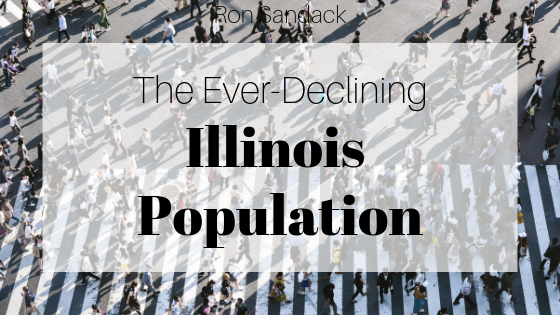Those following me on Facebook or Twitter know I have long discussed the Illinois Exodus problem. The shrinking population of Illinois isn’t exactly a new phenomenon, but that doesn’t make it any less dire. The state has been steadily losing new and current residents for at least five years. Numbers released by the Census Bureau near the end of 2018 revealed just how bad the exodus of Illinois residents has become. From July of 2017 to July of 2018, Illinois lost 45,116 residents. It’s the worst retention rate since Illinois started bleeding residents five years ago, and that total constitutes over a quarter of the 157,000 residents that have left in that time.
To put that in perspective, the number of citizens lost in that period of time is roughly equivalent to the population of Joliet, the third largest city in the state. Last year, approximately 45,000 Illinoisans departed — think of that as Elmhurst, IL evaporating.
While residents leaving a state is to be expected anywhere (especially in cold-weather states like Illinois), there should normally be new residents to help offset the loss. That’s not happening here, and what is especially worrying is the demographics of the residents most likely to leave. Most of the exodus is led by residents aged 29 to 54. This not only depletes the state’s workforce and prevents job growth and innovation, but it also has a minimizing effect on birth rates within the state.
The state has seen a drop of nearly nine percent in annual birth rates since 2011. This drop means that Illinois is slowly but steadily moving to a level of homeostasis between death rates and birth rates.
So why are Illinois residents leaving at such a steady clip? Money seems to be the biggest culprit, and the weak economic opportunities are intrinsically tied up in an anemic job market. The unemployment rate is higher than many other states, and wage growth has largely stagnated. I argue these factors are explicitly tied to Illinois’ fiscal calamity – decades of state over-spending, over-promising, huge public pension problems, other state debt, and very high taxes when taken in the aggregate. The cumulative effect of these conditions is a resounding negative – almost encouraging those who can leave for better prospects elsewhere to do so.
And since these circumstances are driving out the most promising demographic for Illinois’ workforce, it’s developing into a self-perpetuating cycle. Just as worrying is the fact that half of the residents say they’d like to leave the state, and their number one reason is high taxes.
This could be an especially hard pill to swallow for Illinois’ aging population. With fewer residents working, the tax-funded resources keeping pensions afloat in Illinois are steadily shrinking. There’s no simple solution, but the causes of this exodus are pretty apparent. If legislators can’t find a means to create more economic opportunity and a more stable budget, the entire state could eventually find itself in a death spiral.

